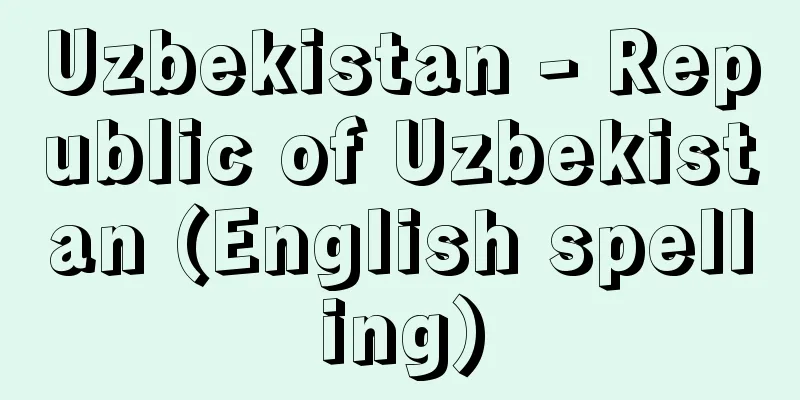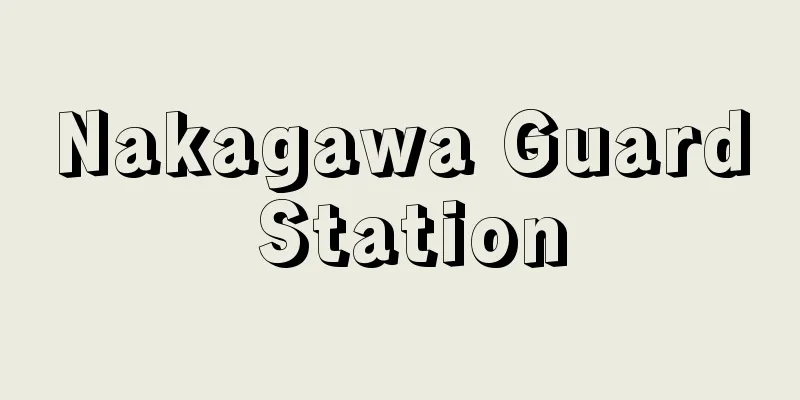Uzbekistan - Republic of Uzbekistan (English spelling)

|
A republic located in Central Asia. It was formerly the Uzbek Soviet Socialist Republic (Узбекская ССР/Uzbekskaya SSR), one of the 15 republics that made up the Soviet Union (USSR), but in August 1991 it gained independence from the federation during the collapse of the Soviet Union and adopted the traditional regional name to become the Republic of Uzbekistan. It borders the republics of Kazakhstan, Kyrgyzstan, Tajikistan, Afghanistan, and Turkmenistan. It has an area of 447,400 square kilometers. Its population is 25,568,000 (estimated 2003), 29,560,000 (estimated 2012). Its capital is Tashkent (population 2.2 million, 2008). It is divided into 12 regions, including the Republic of Karakalpakstan (area 164,900 square kilometers, population 1,570,000, estimated 2007). 80% of the population is Uzbek, with the rest being Russians (5.5%), Tajiks (4.8%), Tatars (1.2%), etc. (1996). [Kimura Hideaki] NatureIt lies between the Amu Darya and Syr Darya rivers, and four-fifths of the country is plain (Turan depression), with mountains only at the eastern end. The plain is divided into three parts: the Ustyurt Plateau, the Amu Darya alluvial delta, and the Kyzylkum Desert. The Ustyurt Plateau is an undulating plateau with an elevation of 200-250 meters, with a clear step at the border with the adjacent plain. The mountainous areas are the Tien Shan, Gissar and Alai mountain ranges, and the valleys between them. The highest point is the highest peak of the Gissar mountain range (4643 m). The main lowlands in this area are the Fergana Basin in the east, the Tashkent-Gorodnosteppe lowland, and the Zeravshan, Kashkadarya and Surkhandarya valleys in the center. The climate is harsh and continental, with mostly sunny days throughout the year. The average January temperature is -6.3°C in Nukus in the northwest and 3°C in Termez in the south. The average July temperature is 26°C (Nukus) to 32°C (Termez). The annual precipitation is 200 mm in the plains and less than 1000 mm in the mountains. Rain falls mainly from winter to spring. The sunshine hours are 190 to 220 days. The main rivers are the Amu Darya, Syr Darya, Zerafshan, and Kashkadarya, which are mainly used for irrigation. There are no rivers in the desert, so the inhabitants use groundwater. Oasis cities such as Tashkent, Fergana, Samarkand, and Khiva are opened at the outlets of the rivers from the valleys and mountains. [Kato Kujo and Kimura Hideaki] historyIn Uzbekistan, the Uzbek Shaybanid dynasty rose to power in the early 16th century, replacing the Mongolian Timurid dynasty, occupying Bukhara, taking Herat, annexing Fergana and Transoxiana, and flourished most during the reign of Abdullah II. After that, the Astrakhan and Manghid dynasties followed, with Bukhara as their capital (the Bukharan Khanate, and under the Manghid dynasty in the 18th century, the Bukharan Emirate). On the other hand, a separate branch of the Uzbeks established the Khiba Khanate in Khorezm in the 16th century, and the Kokand Khanate centered around Kokand in Fergana in the 18th century, and these three khanates continued to fight each other until they were conquered by Russia in the second half of the 19th century. Russia destroyed the Khanate of Kokand, made the Khanate of Khiva and the Emirate of Bukhara protectorates, and in 1867 established a governorate in Tashkent, turning it into a monoculture cotton-growing colony. On November 1, 1917 (the 14th in the Gregorian calendar), a Soviet government was established in Tashkent, mainly composed of Russian railway workers and soldiers. After a civil war and the People's Soviet Revolution in the Khanate of Khiva and the Emir of Bukhara, the current (as of 2012) borders were formed based on the ethnic boundaries of Central Asia, and in 1925, together with Turkmenistan, it was established as a constituent republic of the Soviet Union. On March 24, 1990, Karimov was elected as the first president of a republic that had been a part of the Soviet Union, and on November 1 of the same year, the Council of Ministers and the post of Prime Minister were abolished, and the President took direct control of the Cabinet. Following the August 1991 coup d'état by Gennadiy Yanaev (1937-), then Vice President of the Soviet Union, the country declared independence from the Soviet Union on August 31, and September 1 was designated as Independence Day for the Republic of Uzbekistan. Karimov was elected president in the presidential election on December 29 of the same year. In March 1995, Karimov's term was extended by a national referendum until 2000. Muslims have considerable influence in Uzbekistan, but Islamic fundamentalism is suppressed. A new constitution was adopted on December 8, 1992, and in the first parliamentary elections since independence in December 1994, the People's Democratic Party of Uzbekistan (formerly the Communist Party), the ruling party of the president, won a majority. The Birlik Popular Front, which was founded in 1989, has been outlawed, and religious political parties are banned. Karimov was re-elected in the 2000 presidential election. In 2002, a national referendum was held to amend the constitution, changing the presidential term from five years to seven years. In May 2005, armed groups attacked prisons and other facilities in the eastern city of Andijan, and residents demonstrated against the government, demanding Karimov's resignation. Many people were killed when security forces fired on the crowds while trying to suppress the demonstrations. In the presidential election held in December 2007, Karimov won a landslide victory. The constitution prohibits a third consecutive term, but this was justified on the grounds that he was first elected in 1991 before the constitution was enacted. The parliament is bicameral, with 100 seats in the senate and 150 in the lower house, both of which serve five-year terms. On December 21, 1991, Russia signed the agreement establishing the Commonwealth of Independent States (CIS), becoming a member state of the CIS. It also established diplomatic relations with China in January 1992 and with the United States in February, and joined the United Nations in March. At the end of April 1994, Russia signed a treaty with Kazakhstan and Kyrgyzstan to establish a common economic zone, which included mutual elimination of tariffs, prevention of double taxation, and elimination of obstacles to payments. Furthermore, in July of the same year, an agreement was reached to establish the Central Asian Cooperation and Development Bank, and an interstate conference of the presidents and prime ministers of the three countries was also established, with the aim of unifying economic, foreign and defense policies. Since independence, Uzbekistan has pursued an all-round diplomacy, but after the Andijan incident in May 2005, relations with Western countries that were critical of the Uzbek government's response deteriorated, and Uzbekistan strengthened its ties with Russia and China. In January 2006, Uzbekistan joined the East Asia Economic Caucus (EAEC), and in June, it decided to rejoin the Collective Security Treaty Organization (CSTO). The country has a total military strength of 67,000 (50,000 in the Army and 17,000 in the Air Force). [Kimura Hideaki] Industry and EconomyCotton is the foundation of Uzbekistan's economy, and it once accounted for 60% of the Soviet Union's production, supporting the Soviet cotton industry. However, in terms of investment efficiency, the focus was on expanding factories around Moscow, and Uzbekistan's textile industry did not even meet the needs of its own residents. After the collapse of the Soviet Union, the country promoted the construction of textile factories, reduced cotton cultivation and increased wheat and other crops, and is also trying to achieve food self-sufficiency. Vegetable and melon cultivation is also thriving. The value of grapes and other fruit production accounts for more than half of the total in Central Asia. Natural gas is the most abundant energy resource in the country. The main production areas are Ghazli near Bukhara, the Qashqadarya Basin, and the Fergana Basin. Oil is extracted in the Fergana Basin and Bukhara, and coal is mainly extracted in Angren. Oil can now be exported. Metallurgy and chemical industries are produced in Bekabad, Chirchik, and Samarkand, machinery in Tashkent, Chirchik, Kokand, Andijan, etc. In the light industry, there are cotton weaving factories in Tashkent and other areas. Silk weaving centers are in Namangan and Margilan. A price liberalization policy was introduced on January 10, 1992, but the transition to a market economy is being carried out under government control, and reforms are being carried out toward the formation of a regional market and participation in the global economy, and in this respect it is similar to China. As the industrial workers are still largely Russian, it is expected that Uzbeks will move into the cities. The Korean population, which accounts for just under 1% of the population, is also active. In relation to this, the Korean market has also been remarkable, and passenger cars produced by joint ventures with Korean capital are on the roads. There are also regular air services between Uzbekistan and Seoul, South Korea. In 1994, industrial production was 99.1% of the 1990 level, the smallest decline among the CIS countries. Nevertheless, the economic growth rate continued to decline after independence, but in 1995, it was able to limit it to minus 0.9%, supported by the expansion of agricultural production and strong exports. Since then, the economic growth rate has remained at a high level. The gross domestic product (GDP) was $38.98 billion (2010), the GDP per capita was $1,199 (2009), and the economic growth rate reached 8.1% (2009). The trade volume was exports of $13.04 billion and imports of $8.8 billion (2010). The main export items are petroleum, natural gas, petroleum products, cotton textiles, gold, and energy products, while the main import items are machinery equipment, food products, and chemical products. The main trading partners for exports are Russia, China, Turkey, Kazakhstan, and Afghanistan, while for imports, Russia, China, South Korea, Germany, and Kazakhstan. The trade volume with Japan was exports of 15.1 billion yen and imports of 6.8 billion yen (2010), resulting in an import surplus for Japan. Turkey exports gold and cotton textiles to Japan, and imports automobiles, rubber products, and other products from Japan. The main donor countries to Uzbekistan are Germany, Japan, the United States, and Switzerland (2009), and Japan's cumulative aid up to fiscal 2010 has been approximately 124.975 billion yen in loans, approximately 21.463 billion yen in grant aid, and approximately 12.96 billion yen in technical cooperation. The currency was introduced in som coupons on November 15, 1993, but was changed to the som on July 1, 1994. [Kimura Hideaki] Aral Sea issueCotton production in the Soviet Union, centered in Uzbekistan, increased from 740,000 tons in 1913 to 9.1 million tons in 1980, but the use of water from the Amu Darya and Syr Darya for irrigation caused the Aral Sea to dry up and the water level to drop, leading to the Aral Sea splitting into the Small Aral Sea in the north and the Great Aral Sea in the south in the late 1980s. The water level continued to drop, with sea level elevation dropping from 53 meters in 1960 to 34 meters in 2000, and the sea surface area becoming one-third of its former size. Around 2005, the Great Aral Sea in the south was split into two, east and west, with the eastern part losing 80% of its surface area in the four years from 2006 to 2009. Overall, the sea surface area is thought to be less than 20% of its maximum. Chemical fertilizers, pesticides, salt, and other substances that have been used in the water are scattered from the dried-up seabed, harming people's health, and the infant mortality rate in Karakalpakstan is four times the average for Uzbekistan as a whole. The shrinking of the lake has not only increased the salinity, killing fish and destroying the fishing industry, but it is also having a serious impact on the climate. With the completion of the Kokaral Dike, the Little Aral Sea's surface area has expanded and its salinity is decreasing, but the Great Aral Sea continues to shrink. There is an urgent need to coordinate the interests of the countries along the upstream river and modernize the irrigation system. [Kimura Hideaki] Education and CultureThe education system in Uzbekistan is a four-five-three system with four years of elementary school, five years of middle school, and three years of high school, followed by four years of university. Compulsory education is 12 years from age 7 to 18 (elementary school to high school). Universities include Tashkent State University of Oriental Studies, Tashkent State University of Law, Tashkent State University of Economics, and Samarkand State University of Foreign Languages. The official language is Uzbek, and Russian is also used as a common language. Newspapers include the government-run Pravda Vostoka and Narodnoye Slovo, and the independent Uzland, while news agencies include the state-run Uza and Jahon, as well as Muslim Uzbekistan. Broadcasting is provided by state-run television and radio. [Kimura Hideaki] "The Road to the Commonwealth of Independent States" by Shimotomi Nobuo (1992, Jiji Press) " ▽ "The Ethnic Groups, Economies, and Societies of the CIS Countries - Towards a Union of Eurasian States" by Nakamura Yasuzo (1995, Kokon Shoin)" ▽ "Transformation and Reconstruction of the Russian and CIS Economies" by Nakatsu Takashi (1996, Dobunkan Publishing)" ▽ "Central Asia - The Current Stage and Challenges of Marketization" edited by Shimizu Manabu (1998, Institute of Developing Economies) " ▽ "Modern Russian History and Central Asia" by Kimura Hideaki (1999, Yushindo)" ▽ "Encyclopedia of Central Eurasia" edited by Komatsu Hisao, Umemura Tan et al. (2005, Heibonsha)" ▽ "Uzbekistan - Ethnic Groups, History, and Nation" by Takahashi Iwao (2005, Sodosha)" ▽ "Customary Economy and Market Development: Functions and Structures of Communities in Uzbekistan" by Masato Hiwatashi (2008, University of Tokyo Press) "Uzbekistan after Socialism" by Timur Dadabayev (2008, Institute of Developing Economies) [References] | | | | | | | | [Additional Materials] |"> Uzbekistan flag ©Shogakukan Illustration/Shogakukan Creative "> Uzbekistan location map Source: Shogakukan Encyclopedia Nipponica About Encyclopedia Nipponica Information | Legend |
|
中央アジアに位置する共和国。かつてはソビエト連邦(ソ連)を構成した15共和国の一つ、ウズベク・ソビエト社会主義共和国Узбекская ССР/Uzbekskaya SSRであったが、ソ連崩壊期の1991年8月連邦から独立、従来の地域名を採用してウズベキスタン共和国と改称した。カザフスタン、キルギス、タジキスタン、アフガニスタン、トルクメニスタンの各共和国と接する。面積は44万7400平方キロメートル。人口2556万8000(2003年推計)、2956万(2012年推計)。首都タシケント(人口220万、2008年)。カラカルパクスタン共和国(面積16万4900平方キロメートル、人口157万、2007年推計)と12の州に分かれている。国民の80%はウズベク人で、ほかにロシア人(5.5%)、タジク人(4.8%)、タタール人(1.2%)など(1996)が住む。 [木村英亮] 自然アムダリヤとシルダリヤ両河川の間を占め、国土の5分の4は平野部(トゥラン低地)で、山地は東端だけである。平野部はウスチュルトUstyurt台地とアムダリヤの沖積デルタ地帯、それにキジルクム砂漠の3部分に大別される。ウスチュルト台地は標高200~250メートルの起伏のある台地で、隣接する平野部との境界には明確な段がついている。 山地部は天山山脈、ギッサール山脈、アライ山脈、およびその中間の渓谷である。最高点はギッサール山脈中の最高峰(4643メートル)である。東部のフェルガナ盆地、タシケント・ゴロドノステップ低地、中央部のゼラフシャン渓谷、カシュカダリヤ渓谷、スルハンダリヤ渓谷がこの方面のおもな低地である。 気候は厳しい大陸性で、1年を通じて晴天が多い。1月の平均気温は北西部のヌクスで零下6.3℃、南部のテルメズで3℃である。7月の平均気温は26℃(ヌクス)から32℃(テルメズ)。年降水量は平野部で200ミリメートル、山地で1000ミリメートル以内。雨は主として冬から春にかけて降る。日照時間は190~220日。おもな河川はアムダリヤ、シルダリヤ、ゼラフシャン、カシュカダリヤなどで、主として灌漑(かんがい)に利用される。砂漠地帯には川がなく、住民は地下水を利用している。渓谷や山地からの河川の出口には、タシケント、フェルガナ、サマルカンド、ヒバなどのオアシス都市が開けている。 [加藤九祚・木村英亮] 歴史ウズベキスタンでは16世紀初め、モンゴル系のティームール朝にかわってウズベク人のシャイバーニー朝が興り、ブハラを占領、ヘラトを落とし、フェルガナ、トランスオクシアナを併合、アブドゥッラー2世の治政期にもっとも栄えた。その後ブハラを首都として、アストラハン、マンギット両王朝が続いた(ブハラ・ハン国、18世紀のマンギット朝の下ではブハラ・エミール国)。他方ウズベク人の別派は16世紀にホラズムにヒバ・ハン国、18世紀フェルガナのコーカンドを中心としたコーカンド・ハン国を興し、この三つのハン国の間で抗争を繰り返してきたが、19世紀後半になってロシアに征服された。 ロシアはコーカンド・ハン国を滅ぼし、ヒバ・ハン国、ブハラ・エミール国は保護国とし、1867年タシケントに総督府を置き、綿花栽培のモノカルチュア(単一耕作)植民地とした。 1917年11月1日(新暦14日)、タシケントで、ロシア人鉄道労働者や兵士を中心とするソビエト政府が成立した。国内戦やヒバ・ハン国、ブハラ・エミール国における人民ソビエト革命を経て、中央アジアの民族的境界区分によってほぼ現在(2012年時点)の国境が形成され、1925年にトルクメニスタンとともにソ連の構成共和国として発足した。 1990年3月24日、ソ連構成共和国では初めての大統領として、カリモフが選ばれ、同年11月1日には閣僚会議と首相のポストが廃止され、大統領が内閣を直接統率することとされた。1991年8月に勃発(ぼっぱつ)した、当時ソ連の副大統領であったヤナーエフГеннадий Янаев/Gennadiy Yanaev(1937― )らによるクーデター事件後の8月31日にソ連からの独立を宣言、ウズベキスタン共和国として9月1日を独立記念日とした。同年12月29日の大統領選挙でカリモフが大統領に選出された。カリモフは1995年3月には国民投票で任期を2000年まで延長した。ウズベキスタンではイスラム教徒がかなりの勢力をもっているが、イスラム原理主義は抑圧されている。1992年12月8日には新憲法を採択、1994年12月独立後初めての議会選挙で大統領与党ウズベキスタン人民民主党(旧共産党)が過半数を獲得した。1989年結成の人民戦線ビルリクは非合法化され、宗教政党は禁止されている。 2000年の大統領選挙ではカリモフが再選を果たした。2002年に国民投票で憲法を改正し、大統領の任期を5年から7年へと変更した。2005年5月、東部の都市アンディジャンで武装勢力による刑務所などの襲撃や住民によるカリモフ辞任要求反政府デモなどが起き、その鎮圧の際に治安部隊の群衆への発砲で多数の死者が出た。2007年12月に行われた大統領選挙ではカリモフが大勝した。憲法には連続3選を禁止する規定があるが、1991年の初当選時は憲法制定以前であったことを理由に正当化された。議会は二院制で、議席数は上院100、下院150、任期はともに5年である。 1991年12月21日、独立国家共同体(CIS)創設協定に調印し、CIS加盟国となった。また1992年1月に中国と、2月にアメリカと国交を開き、3月には国連に加盟した。1994年4月末にはカザフスタン、キルギスと関税の相互撤廃、二重課税防止、決済の障害排除を内容とする共通経済圏創設に関する条約に調印した。さらに同年7月には、中央アジア協力開発銀行の創立でも合意し、3国の大統領・首相による国家間会議も創設され、経済、外交、防衛政策で統一していくことになった。 独立以来全方位外交を進めてきたが、2005年5月のアンディジャン事件をきっかけに、一時ウズベキスタン政府の対応に批判的な欧米諸国との関係が悪化し、ロシア、中国との関係強化が進んだ。すなわち、2006年1月にはユーラシア経済共同体(EAEC=East Asia Economic Caucus)に加盟、6月にはCIS集団安全保障条約機構(CSTO=Collective Security Treaty Orgnization)に復帰を決定した。総兵力は6.7万(陸軍5万、空軍1万7000)ほか。 [木村英亮] 産業・経済ウズベキスタン経済の基盤は綿であり、かつてはソ連の生産の6割を占め、ソ連の綿工業を支えていた。しかし、投資効率の面からモスクワ周辺の工場の拡張に重点が置かれ、ウズベキスタンの織物工業は自国の住民の需要さえ満たしていなかった。ソ連解体後は、織物工場の建設を進めるとともに、綿の栽培を減らして小麦などを増やし、食糧自給も達成しようとしている。野菜とウリの栽培も盛んである。ブドウをはじめとする果樹の産額も、全中央アジアの半分以上を占める。 エネルギー資源としては天然ガスがもっとも豊かである。主要な産地はブハラ付近のガズリのほか、カシュカダリヤ流域、フェルガナ盆地などである。石油はフェルガナ盆地とブハラで、石炭は主としてアングレンで採掘されている。石油は輸出も可能になった。 冶金(やきん)と化学工業はベカバド、チルチク、サマルカンド、機械類はタシケント、チルチク、コーカンド、アンディジャンなどで生産される。軽工業ではタシケントをはじめ各地に綿織物の工場がある。絹織物の中心はナマンガン、マルギランである。 1992年1月10日価格自由化政策を導入したが、市場経済化は政府の統制下に行われ、地域市場の形成、世界経済への参加へ向け改革を進めており、この点では中国に似ている。 工業労働者は依然としてロシア人が多いので、ウズベク人の都市への進出が期待されている。人口の1%弱の朝鮮人の活躍も目だっている。これに関連して、韓国の進出も目覚ましく、韓国資本との合弁企業が生産した乗用車が走っている。また韓国のソウルとの間に定期航空便も通じている。1994年の工業生産は1990年の99.1%で、CIS諸国のなかではもっとも落ち込みが小さかった。それでも経済成長率は独立以降マイナスが続いたが、1995年になって、農業生産の拡大および好調な輸出に支えられてマイナス0.9%にとどめることができた。その後、経済成長率は高水準で推移。国内総生産(GDP)は389.8億ドル(2010)、1人当りGDPは1199ドル(2009)で、経済成長率は8.1%(2009)に達している。 貿易額は輸出130.4億ドル、輸入88億ドル(2010)。おもな輸出品目は石油、天然ガス、石油製品、綿繊維、金、エネルギー製品、おもな輸入品目は機械設備、食料品、化学製品である。おもな貿易相手国は輸出がロシア、中国、トルコ、カザフスタン、アフガニスタン、輸入はロシア、中国、韓国、ドイツ、カザフスタンである。日本との貿易額は、輸出151億円、輸入68億円(2010)で日本の輸入超過となっている。日本へは金、綿繊維などを輸出し、日本から自動車、ゴム製品などを輸入している。 ウズベキスタンへの主要援助国はドイツ、日本、アメリカ、スイス(2009)などで、日本の援助は2010年度までの累計で、有償資金協力約1249.75億円、無償資金協力約214.63億円、技術協力実績約129.6億円、となっている。 通貨は、1993年11月15日にスム・クーポンが導入されたが、1994年7月1日にスムに変更された。 [木村英亮] アラル海問題ウズベキスタンを中心とするソ連の綿の生産は、1913年の74万トンから1980年には910万トンへと増大したが、灌漑(かんがい)のためアムダリヤ、シルダリヤの水が利用されたため、アラル海が干上がり、水位が下がって、1980年代後半には北部の小アラル海と南部の大アラル海に分かれた。水位の低下はさらに進み、1960年には53メートルであった海面高度が2000年には34メートルとなり、海面面積はもとの3分の1になった。2005年ごろには南部の大アラル海が東西二つに分断され、東側は2006年から2009年の4年間に8割が失われた。全体として、海面面積は最大時の2割以下になったとみられる。 干上がった海底から、投入された化学肥料や農薬、塩などが飛散し、人々の健康を害し、カラカルパクスタンの幼児死亡率はウズベキスタン全体の平均の4倍である。湖の縮小は、塩分を濃くして魚類を死滅させ漁業を破滅させたばかりでなく、気候にも深刻な影響を与えている。小アラル海はコカラル堤防の完成により海面面積も広がり、塩分濃度も下がりつつあるが、大アラル海の縮小は依然続いている。早急に上流河川の国々を含めた利害関係を調整し、灌漑システムを近代化することが急務である。 [木村英亮] 教育・文化ウズベキスタンの教育制度は小学校4年、中学校5年、高等学校3年の四・五・三制で、その上に大学4年がある。義務教育は7歳から18歳まで(小学校~高等学校)の12年間。大学にはタシケント国立東洋学大学、タシケント国立法科大学、タシケント国立経済大学、サマルカンド外国語大学などがある。公用語はウズベク語で、ロシア語も共通語として使われている。 新聞には政府系のプラウダ・ボストーカ、ナロードノエ・スロボ、独立系のウズランドなど、通信社には国営のウザ、ジャホンのほかムスリム・ウズベキスタンなどがある。放送には国営のテレビ、ラジオがある。 [木村英亮] 『下斗米伸夫著『独立国家共同体への道』(1992・時事通信社)』▽『中村泰三著『CIS諸国の民族・経済・社会――ユーラシア国家連合へ』(1995・古今書院)』▽『中津孝司著『ロシア・CIS経済の変容と再建』(1996・同文館出版)』▽『清水学編『中央アジア――市場化の現段階と課題』(1998・アジア経済研究所)』▽『木村英亮著『ロシア現代史と中央アジア』(1999・有信堂)』▽『小松久男・梅村坦他編『中央ユーラシアを知る事典』(2005・平凡社)』▽『高橋巌根著『ウズベキスタン――民族・歴史・国家』(2005・創土社)』▽『樋渡雅人著『慣習経済と市場・開発――ウズベキスタンの共同体にみる機能と構造』(2008・東京大学出版会)』▽『ティムール・ダダバエフ著『社会主義後のウズベキスタン』(2008・アジア経済研究所)』 [参照項目] | | | | | | | | [補完資料] |"> ウズベキスタンの国旗 ©Shogakukan 作図/小学館クリエイティブ"> ウズベキスタン位置図 出典 小学館 日本大百科全書(ニッポニカ)日本大百科全書(ニッポニカ)について 情報 | 凡例 |
<<: Uzbek - Uzbek (English spelling)
>>: Acystopteris japonica (Luerss.) Nakai
Recommend
Climats
…During World War I, he served in the British Arm...
Family tradition - Kaden
〘noun〙① Something that has been handed down for ge...
Temperate summer rainy climate - Ontainatsuamekiko
A temperate climate with a dry winter and lots of...
Tariff negotiations
The 6th General Tariff Negotiations, organized by...
Treaty of Westminster
Four treaties were concluded between England, the ...
oneiroide Erlebnisform (English notation) oneiroide Erlebnisform
...In Japan, the following three different states...
Forqueray, JBA (English)
...By the second half of the 17th century, the tr...
Kyummel Doll - Kyummel Doll
...30% or more sugar, 50% alcohol. In France, the...
Wendigo - Wendigo
...There are also many examples of monsters that ...
Reverse extrusion
...Products made by extrusion include aluminum sa...
Irino Pine Grove - Irino Pine Grove
A pine forest stretching about 4km along the coast...
Bulkhead deck - bulkhead deck
...However, since it is difficult to theoreticall...
Sotaro Iba
1851-1903 A swordsman and educator from the Meiji...
Vittorio (English spelling) Giuseppe di Vittorio
1892‐1957 Italian labor leader. He started out as ...
Kuan Thien Pak - Kuan Thien Pak
…(2) Dan Bau (Dan Bau) or Dan Doc Huyen (Dan Duc ...



![Mizunami [city] - Mizunami](/upload/images/67ccf12a9a795.webp)





